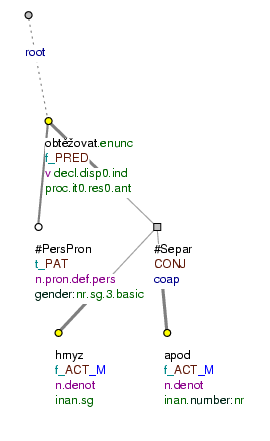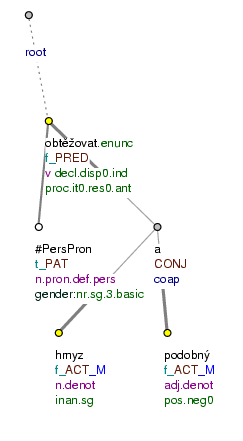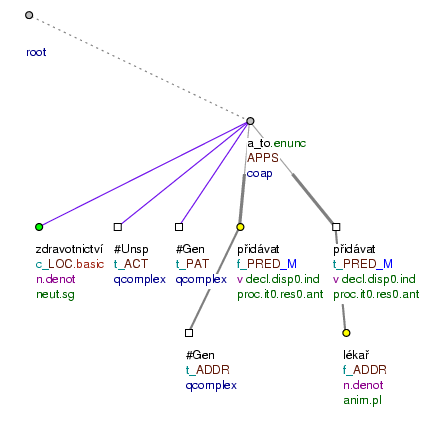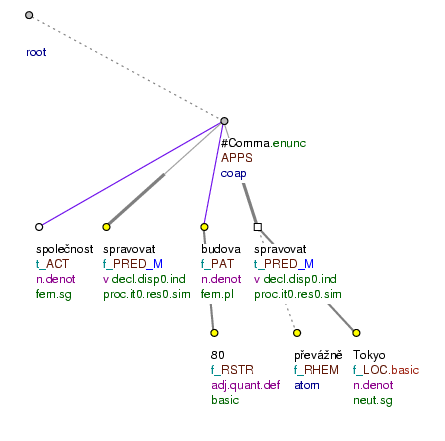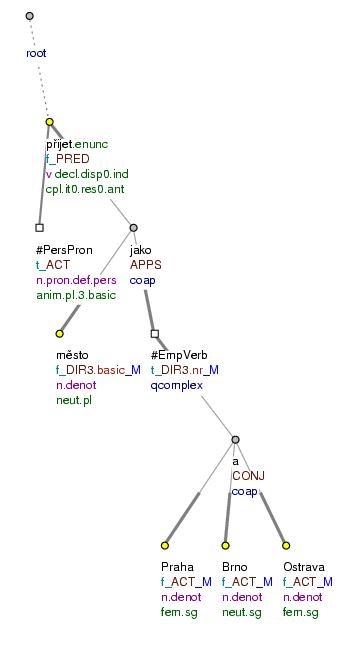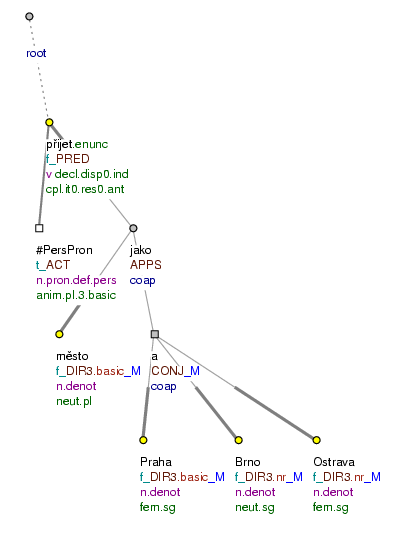Only those connections are considered coordination or apposition that are formally paratactic, i.e. those making use of coordinating connectives (each connective is considered either coordinating, or subordinating on the basis of certain formal and semantic criteria; for more details on coordinating connectives see Section 16.1, "Co-ordinating connectives").
Concerning hypotactic connections with a potential meaning of coordinating functors (see Section 12.1, "Functors for coordination"), we respect the fact that the speaker has chosen the hypotactic form and we do not assign the sentence a paratactic structure. Semantically equivalent connections, one in a paratactic and the other one in a hypotactic form, therefore, have two different but equivalent functors, one for a paratactic connection and the other for a hypotactic connection. Cf.:
-
Pospíchal, ale.
ADVSpřesto nám pomohl. (=lit. (He) was_in_a_hurry but yet (he) us helped.) -
<Přestože> pospíchal.
CNCS, pomohl nám. (=lit. Although (he) was_in_a_hurry but yet (he) helped us.)
-
<Zatímco> loni ceny zboží klesaly.
CONTRD, letos se zvyšují. (=lit. While last_year prices (of) goods were_decreasing, this_year - (they) are_increasing.) -
Loni ceny zboží klesaly, a.
CONFRletos se naopak zvyšují. (=lit. Last_year prices (of) goods were_decreasing, and this_year - on_the_contrary (they) are_increasing.)
False dependent clauses and expressions like tatínek s maminkou (=lit. daddy with mummy) are also not represented as coordination. The annotation of false dependent clauses is described in Section 5.4, "False dependent clauses", the annotation rules for expressions like tatínek s maminkou (=lit. daddy with mummy) are in Section 11.1.1, "Ambiguous relations with adjuncts expressed by prepositional phrases".
As for apposition, only the so-called loose apposition, separated by a comma is considered apposition; e.g.:
český král, Karel (=lit. (the) Czech king, Karel)
hlavní město, Praha (=lit. (the) capital -, Prague)
If the connection is not loose (no comma; e.g.: český král Karel (=lit. Czech king Karel); hlavní město Praha (=lit. (the) capital Prague); stalo se to v Praze na Vyšehradě (=lit. (it) happened -in Prague at Vyšehrad); v únoru v roce 1999 (=lit. in February in year 1999)), the expression is not considered apposition and the annotation follows different rules (see especially Section 11.3, "Mutual relation of two or more locative/directional or temporal modifications").
The following special constructions are also represented in the form of coordination or apposition:
-
special constructions - coordination:
-
coordinations with atd. (=etc.), apod. (=and the like), aj. (see Section 6.2.1.1, "Coordination with "atd.", "apod.", "aj."").
-
-
special constructions - apposition:
-
appositions with modifications additionally connected (by means of the following expressions: a to, a sice; see Section 6.2.1.2, "Apposition with an additional modification (connected by means of "a to", "a sice")"),
-
appositions with the conjuction jako (=such as/like) (see Section 6.2.1.3, "Apposition with the conjunction "jako""),
-
Constructions connected by means of což (=which) are also considered paratactic (these constructions are described in Section 5.4.1.1, "Constructions with the connectives "což", "přičemž", "načež", "pročež", "začež", "aniž""); the same applies to certain special structures such as addresses, sport results, abbreviated forms in brackets following the full expression etc. These cases are described in Section 12, "Annotation of structured text".
Expressions (lists) ending with apod., atd., aj. or three dots are also represented as coordinations; the root nodes of these structures are assigned the CONJ functor.
The root node of such a paratactic structure is represented by the node representing the comma (t_lemma=#Comma), or by a newly established node with the t-lemma #Separ (if there is no comma present in the surface structure of the sentence). The node representing the abbreviation or three dots (t_lemma=#Period3) is represented as a terminal member of the paratactic structure and its functor is identical to the functors of the other terminal members; the value of its is_member attribute is also 1.
Examples:
Obtěžoval ho hmyz.ACT [is_member=1] apod..ACT [is_member=1] {#Separ.CONJ} (=lit. Bothered him insect, and_similarly.) Fig. 6.97
Rádi navštěvujeme hrady.PAT [is_member=1] , zámky.PAT [is_member=1] , skanzeny.PAT [is_member=1] apod..PAT [is_member=1] [#Comma.CONJ] (=lit. (We) like visiting castles, manors, open-air_museums and_similarly.)
V koupelně musí téct.PRED [is_member=1] teplá voda, v obývacím pokoji nesmí chybět.PRED [is_member=1] televize, kuchyně se neobejde.PRED [is_member=1] bez myčky na nádobí atd..PRED [is_member=1] [#Comma.CONJ] (=lit. In (the) bathroom has_to flow hot water, - (the) living room must_not lack television,(the) kitchen cannot_do without (a) dishwasher - - and_so_on.)
Naše škola nabízí řadu volitelných předmětů: cizí jazyky.PAT [is_member=1] , religionistiku.PAT [is_member=1] , rodinnou výchovu.PAT [is_member=1] , aj..PAT [is_member=1] [#Comma.CONJ] (=lit. Our school offers (a) range (of) optional courses: foreign languages, religion, family education etc.)
Non-abbreviated form. If the expression does not occur in its abbreviated form but in the full one (a podobně (=lit. and similarly) , a tak dále (=lit. and so on), a jiné (=lit. and others)), the paratactic structure root node is represented by the node for the conjunction a (=and). The remaining parts of the expression (podobně (=similarly), jiné (=others), tak dále (=so on)) are represented as a terminal member of the paratactic structure. If the remaining part consists of more words (tak dále (=so on)) it is represented as a non-verbal idiomatic expression (see Section 8.1, "Non-verbal idioms").
Example:
Obtěžoval ho hmyz.ACT [is_member=1] a.CONJ podobně.ACT [is_member=1] (=lit. Bothered him insect, and_similarly) Fig. 6.98
Additional modifications connected by means of a to, a sice are considered to be verbal clauses with the governing verb elided; such a clause is connected in apposition (the meaning is that of specification, giving a concrete example).
These constructions are represented as clausal parataxis (see Section 6.1.2, "Parataxis of sentence parts, parataxis of clauses and mixed parataxis"), as apposition of two predicates. The node representing the governing verb of the preceding clause is copied into the second clause.
Dependent modifications of the predicate in the first clause can be usually represented as shared modifiers.
If the additional modification is a valency modification, it is represented by a node with the t-lemma #Gen in the subtree of the first clause.
The paratactic structure root node is represented by the nodes for the connectives a to (t_lemma=a_to) or a sice (t_lemma=a; sice is assigned a separate node with the functor CM; see Section 16.1, "Co-ordinating connectives").
Compare:
-
Ve zdravotnictví přidávali, a to lékařům. (=lit. In health_services (they) raised_salaries, and that (those) (of) doctors.)
=Ve zdravotnictví přidávali, a to přidávali lékařům. (=lit. In health_services (they) raised_salaries, and that (they) raised_salaries (of) doctors.)
In the second clause, there is ellipsis of the governing predicate přidávat (=to_raise_(one's)_salary). There is a relation of apposition between the expressed predicate of the first clause and the elided predicate of the second clause. Since the additional modification (the Addressee lékařům (=to_doctors)) is a valency one, the absent Addressee of the predicate in the first clause is represented by a newly established node (
t_lemma=#Gen). The Patient, absent in the surface structure, is represented as a shared modifier of both predicates. Cf. Fig. 6.99.
Other examples:
Studenti se sjedou.PRED [is_member=1] na demonstraci, a to.APPS { sjet_se.PRED [is_member=1]} do Prahy. (=lit. Students will_gather for (a) demonstration, and that to Prague.)
České dráhy chtějí pronajímat.PRED [is_member=1] {#Gen.ADDR} prostory v železničních stanicích, a.APPS sice { pronajímat.PRED [is_member=1]} vždy jedné firmě.ADDR (=lit. (The) Czech railways want_to rent (the) space of railway stations, and that always (to) one firm.)
Asyndetically connected additional modifications. Modifications connected simply by means of a punctuation mark followed by a rhematizer are represented in a way similar to additional modifications connected by a to, a sice.
The node representing the governing verb of the preceding clause is copied into the second clause. The node representing the rhematizer depends on the node representing the verb as the left-side sister of the additional modification.
The root node of the appositional structure is represented by the node for the comma (t_lemma=#Comma).
Examples:
Společnost spravuje.PRED [is_member=1] 80 budov, převážně.RHEM { spravovat.PRED [is_member=1]} v Tokiu. (=lit. (The) company administers 80 buildings, mainly in Tokio.) Fig. 6.100
Ve zdravotnictví přidávali.PRED [is_member=1] {#Gen.ADDR} , zejména.RHEM { přidávat.PRED [is_member=1]} lékařům. (=lit. In health_services (they) raised_salaries, especially (those) (of) doctors.)
NB! If there is no comma in the construction (e.g. Společnost spravuje 80 budov převážně v Tokiu. (=lit. (The) company administers 80 buildings, mainly in Tokio.)), there is no apposition in the construction.
Within mixed appositions (a noun and a clause), a special type of construction is represented by a construction with the conjunction jako (=such_as/like).
There are two basic situations:
-
the conjunction "jako" is followed by a clause with the verb "být".
If the conjunction jako (=such_as/like) is followed by a clause the governing verb of which is být (=to_be), a mixed apposition of a noun and this verb is represented in the tree. The node representing the verb být (=to_be) has the same functor as the node representing the non-verbal terminal member of the apposition (i.e. the node representing a noun).
The verb být (=to_be) is a copula in such cases (see Section 2.1.3, "Copula "být" (verbonominal predicate)"), therefore, the node representing the nominal part of the verbonominal predicate (
functor=PAT)is copied under the node for být (=to_be); this nominal part is the first member of the apposition.Compare:
-
Váže těžké kovy, jako je plutonium. (=lit. (It) binds (to) heavy metals such_as - plutonium.)
In the tree, there is a mixed apposition: between the node representing the noun kovy (=metals) and the node representing the verb být (=to_be). The modification kovy (=metals) represents the Patient of the verb vázat (=to_bind). The node representing the verb být (=to_be) has also the
PATfunctor. The newly established node for the nominal part of the predicate (this node is a copy of the node representing the noun kovy (=metals)) depends on the node for být (=to_be). Cf. Fig. 6.101.
Other examples:
Nechybí osobnosti.
ACT[is_member=1] , jako.APPSbyli.ACT[is_member=1] A. Loos, J. Hoffmann { osobnost.PAT} (=lit. (There)_(is) _no)_lack (of) personalities like A. Loos, J. Hoffmann.)Vzruch přinášejí skladby.
ACT[is_member=1] s nervní kytarou, jako.APPSje.ACT[is_member=1] divoké Kiss { skladba.PAT} (=lit. Excitement bring compositions with (a) nervous guitarre such_as - wild Kiss.) -
-
the conjunction" jako" is not followed by a clause with "být".
If there is no verb být (=to_be), it is necessary to identify the elements between which there is the apposition relation.
The conjunction "jako" is followed by a noun phrase with its governing element in the nominative.. If the conjunction jako (=such_as/like) is followed by a noun phrase with its governing element in the nominative form, there is a mixed apposition in the tree: between the node representing the noun and a newly established node for an empty verb (the empty verb substitutes for the elided verb být (=to_be),
t_lemma=#EmpVerb). The newly established node has the same functor as the node representing the first member of the apposition. The node representing the expressed modification in the nominative depends on the node for the empty verb and its functor isACT. Cf.-
Přijeli do měst, jako Praha, Brno a Ostrava. (=lit. (They) came to towns like Prague, Brno, Ostrava.)
In the tree, there is a mixed apposition of the node representing the prepositional phrase do měst (=lit. to towns) and the newly established node representing an empty verb. The prepositional phrase do měst (=lit. to towns) is a modification with a directional meaning, it is assigned the functor
DIR3, the node representing the empty verb is assigned the same functor:DIR3. The nodes representing the modifications Praha , Brno and Ostrava depend on the node representing the empty verb and they are assigned theACTfunctor. Cf. Fig. 6.102.
NB! No node representing the nominal part of the verbonominal predicate is inserted into the structure under the empty verb (
t_lemma=#EmpVerb)!The conjunction "jako" is not followed by a noun phrase the governing element of which has the nominative form. If the conjunction jako (=such_as/like) is followed by a prepositional phrase or a noun phrase (in a non-prepositional case form) in the form identical to that of the other member of the apposition, the structure is interpreted as apposition of sentence parts. Cf.
-
Přijeli do měst, jako do Prahy, Brna, Ostravy. (=lit. (They) came to towns such_as to Prague, Brno, Ostrava.)
In the tree, there is apposition of sentence parts between the prepositional phrase do měst (=in towns) and the coordination of the prepositional phrases do Prahy, Brna a Ostravy (=lit. to Prague, Brno, Ostrava). The terminal members of the apposition will be represented by four nodes: do měst (=to towns), do Prahy (=to Prague), do Brna (=to Brno), do Ostravy (=to Ostrava). Cf. Fig. 6.103.
Other examples:
Organizoval kulturní akce.
PAT[is_member=1] , jako.APPStřeba poláčkovskou konferenci.PAT[is_member=1] v Rychnově. (=lit. (He) organized cultural events such_as for_example (the) (on)_Poláček conference in Rychnov.) -
The root node of the apposition is always the conjunction jako (=such_as/like).
Figure 6.101. Mixed apposition with the conjunction "jako"
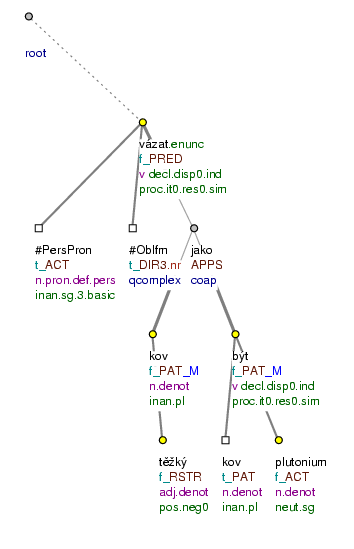
Váže těžké kovy, jako je plutonium. (=lit. (It) binds to heavy metals such_as - plutonium.)
